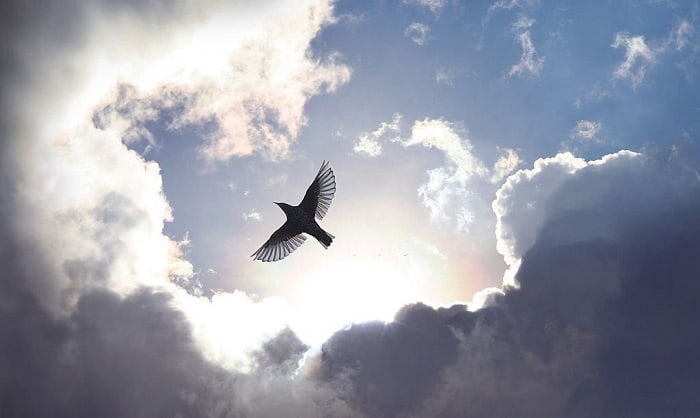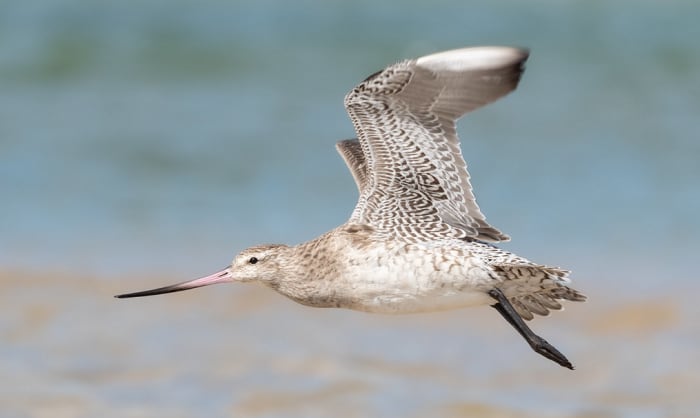How far can a bird fly without stopping? A bar-tailed godwit has the record as the longest flying bird that traveled 7,500 miles nonstop. This is an impressive feat that broke the longest nonstop flight among birds known to scientists.
Learn more about this bird and the distance it flew that gained it the nickname “jet fighter.” Read on.
Table of Contents
How Far Can a Bird Fly Without Landing?
- A bird you see in your backyard can probably stay in the air for five to six hours at a speed of 15 mph to 20 mph. Given their maximum endurance, they can cover more or less 90 to 100 miles.
- Wandering albatrosses are among the largest seabirds, with the widest wingspan measuring approximately ten feet or more. They can reach an impressive record around 10,000 miles, flying over the sea without landing.
- How do they do this? Albatrosses use their impressive wingspread to ride the ocean winds, glide for extended periods, and only flapping their wings a few times.
- This technique is called dynamic soaring, ideally used when the wind speed exceeds 18 miles per hour. That is how Albatroses save their energy and can fly longer without stopping.
- Another spectacular record is that of the Common Swift. It is a medium-sized migratory bird that spends almost its whole life airborne. Their uninterrupted intercontinental trip once reached roughly 6,000 miles.
It is recorded as the longest uninterrupted flight and can stay longest in air for 10 months.
- How do they eat, sleep, and molt? Swifts forage along the way, feeding on the flying insects swept by the wind.
- For sleep, they do it in the air! Unlike most birds, they molt feather by feather, so it is not a hindrance to their flight.
What Bird Can Fly the Farthest Without Stopping?
A male bar-tailed godwit with the scientific name Limosa lapponica is the new record holder for nonstop bird migration.
The large and loud cinnamon-colored bar-tailed godwit is said to have the aerodynamic build of a “jet fighter.” It departed from the mudflats of southwest Alaska on September 16th, taking the direct route south to reach the Firth of Thames near Auckland, New Zealand, 11 days later.
The bird flew across the Pacific Ocean over Aleutian Island, facing the strong easterly winds, slightly delaying their arrival.
The point-to-point flight recorded by the satellite has an approximate total flight time of 224 hours, with an estimated speed of 55 miles per hour. The recorded distance is 12,854 kilometers but is estimated to be 12,000 kilometers to account for the rounding errors.
Bar-tailed godwit flocks cover a different distance each migration. They can make navigational decisions depending on the weather and the winds.
Any slight difference can affect the mileage. However, despite the variables, these birds are accurately consistent as they return to the same site each migration season within a few days.
Can Birds Sleep While Flying?
Yes. Birds sleep while flying, and scientists observed avians sleeping mid-flight.
They attached a device to frigate birds to identify if they were asleep while flying over the ocean. The study discovered that the birds exhibit two phenomena:
- Unihemispheric slow wave sleep (USWS) or sleeping in only one hemisphere of the brain. This means only one hemisphere of the bird’s brain sleeps whereas the other one stays alert for potential danger.
- Bi-hemispheric sleep, where both brains are asleep simultaneously.
- In addition, the occasional fleeting REM sleep cycles did not impact the birds’ journey whatsoever.
What is the Typical Range of a Bird’s Flight?
This can vary depending on the bird species, air temperature, and the prevailing winds. They can also maximize their speed when chased by a predator or they can compromise between range and speed.
- Dove, geese, seagull, and most birds can fly an average distance of 15 to 55 miles per hour.
- Birds traveling at 15 mph can remain airborne for 6 hours at most, which amounts to 90 miles. Flying at a faster speed will reduce the time the bird can stay aloft.
- A crow fly without stopping from 30 to 60 miles per hour, sustaining a speed of 70 miles per hour when diving.
What is the Longest Bird Migration?
The bird that can fly the longest in migration is the Artic Tern. It is by far the record-breaking and longest known migration, with 55,923 miles (90,000 km) traveled from Greenland to the Weddell Sea each year.
Throughout their 30 years lifespan, this distance can add up to 1.5 million miles, about three times the journey to the moon and back.
How Far Can a Bird Fly in a Day?
For avians flying at an average speed of 20 to 30 miles an hour, they can travel for approximately 160 miles a day. These are birds that don’t normally fly for over 8-10 hours per day. Furthermore, migrating birds can go up to 600 miles each day.
Conclusion
Now you know how long and how far can a bird fly without stopping. It is fun to hear about these monumental accomplishments, especially when you are a birder or love birds.
The next time you see birds flying in the distance, you’ll have an idea of how amazing they are and the distance they can travel in the air. Share this article with anyone who might enjoy reading it and leave a comment below. We love hearing from you!
Moreover, you also can refer more to other flying bird topics:

George and I became friends after a birdwatching trip with our new group. And we have been enjoying every adventure together. When he told me the idea of establishing a site that shares our experiences and fun, I immediately agreed. After trials and errors, here we have Thayerbirding.
















